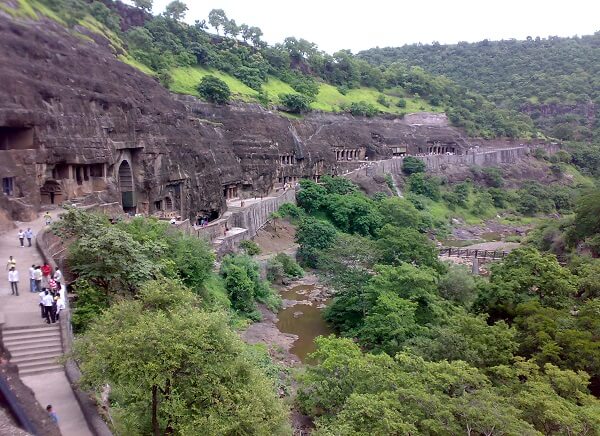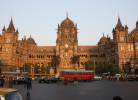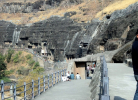Ajanta Caves Aurangabad, Maharashtra
Visitor Information:

-
Famous For History, Photography, Sculptures, Carvings
-
Fee Guide in Detailed Below
-
Visiting Time 9:00AM - 5:30 PM
-
Duration of Visit 2 to 3 hours
A group of 29 caves constitute the Ajanta group of Caves. This group of caves is famous for its collection of ancient unique Buddhist architecture, paintings, sculptures, ancient engineering skills and much more. The caves provide much information about different Buddhas who gave away Earthly possessions to reach nirvana.
Although an important pilgrimage destination for Buddhists, this attraction receives an equal number of pilgrims and tourists, every year.
Apart from Buddhist cultural elements, you can also find a few Hinduism and Jainism religious elements in these caves. This group of caves was recognized as a heritage site in 1983 by UNESCO.
Location of Ajanta Caves
Ajanta caves are located 400 km away from the city of Mumbai and 104 km away from Aurangabad. This group of caves is located in Maharashtra.
History of Ajanta Caves
According to archeologists, the caves were built in two phases by Buddhist monks who took shelter in these caves. To spend their free time, they used primitive tools to create masterpieces inside the caves.
Later, these caves became the home for many monks who spent all their monsoon times here. Many merchants and pilgrims who visited India during the ancient times also took shelter in these caves and some even contributed to the same.
The first phase of construction started around the 2nd century BC and the second phase started in 600 BC.
Indications about Ajanta Caves are mentioned in many literature and inscriptions belonging to the medieval Chinese era and the Mughal era. There are details about the caves in 17th-century Akbar-era literature.
However, the caves were long forgotten and in 1819, Captain John Smith visited the region for hunting tigers. He was surprised to see a horse-shoe shaped cave covered with debris. He commanded a clearance operation and re-discovered the caves.
Later, the Captain even vandalized the caves to inscribe his name and date of discovery, right over a painting of Bodhisattva. In the 1840s, the caves started to get more attention and a Bombay Cave Temple Commission was established to maintain and record the cave details.
In 1920, Hyderabad Nizam appointed a counsel to restore many paintings and sculptures and converted it into a museum with an entry fee for tourists.
However, this led to mismanagement and damage to many important paintings and structures. After independence, the caves came under the control of the government of India and is now controlled by ASI.
Significance of Ajanta Caves
These caves are a classic example of Buddhist styled culture, architecture, religious teachings and so on. Each cave’s paintings and work also reflect on the reign under which the region fell.
Different time periods also showcases unique differences in art. The basic elements of the importance of this group of caves are carvings, ceiling paintings, rock-cut sculptures, halls, and others. The 29 caves of this group can be broadly classified into Viharas and Chaityas.
Viharas hold monasteries, which were primarily used for learning and preaching. The Chaityas were used for religious purposes like meditation, chanting, rituals and others. Similar styles of structures are found in many parts of the country like Bagh Caves, Badami caves, Elephanta Caves and others.
This indicates that there was a significant exchange of knowledge and skill among people under different regions, religions, reigns, and other differences.
The second most important significance is secularism. This is predominantly a Buddhist architecture, which was used for preaching the religion.
However, there are significant elements of other religions too. This showcases that the ancient Indians accepted other religions and held them with the same dignity and respect as their own religion.
These caves are a fusion of frescos, sculptures, and paintings. Each style of art represents a different style of Buddhism. In most cases, Buddha is usually represented with a symbol like a footprint, throne, and others.
Jataka tales are considered as stories from previous lives of Buddha. These stories are found only in the second phase of caves, which were built between the 1st and 5thAD.
Thus, after-life concepts are assumed to be incorporated by Buddhists in later days. With the number of inscriptions, it is found that many kings of various religions and creed funded this cave. The most funding came from Rashtrakuta and Chalukya reign. The ancient caves are of simple decoration and intricate carvings.
However, the caves built during the 5th century are of more ornate types with high decorations. This is due to the influence of Gupta culture. (source: https://whc.unesco.org/en/list/242/).
Inside Ajanta Caves
There are 29 caves in this group and these are numbered for convenience purpose and is not an indication of Chronological order or cultural importance order.
Cave 1
Cave 1 is divided into 14 different cells. Each cell has sculptures representing royal life. This is assumed to be a description of all the earthly possessions that numerous monks left behind in pursuit of enlightenment. There are paintings and sculptures representing the lives of Samkhapala, Champeyyajataka, Mahajanaka, Sibi, and others. The prominent feature of this cave is the Dharmachakrapravartana pose of Buddha.
Cave 2
This cave is dedicated to representing women prowess. This cave is divided into 2 parts. One of the parts holds sculptures and paintings dating back to the 4th and 5thAD. You can find many paintings and statues f Hariti, Yaksha, Padmanidhi, Sankhanidhi, Pancika, and others. This cave is famous for intricate ceiling painting.
Cave 3
Unfinished cave with various paintings and sculptures at different levels of development. There is no definite reason why the cave was unfinished.
Cave 4
This cave holds the largest monastery in this group of caves. This monastery holds explicit large halls, sanctum sanctorum, several paintings, large sculptures, pillared verandah, and others.
Cave 5
Unfinished cave, which was abandoned during construction
Cave 6 and 7
This is considered to be an extension of nearby caves and holds many paintings related to the second phase of construction.
Cave 8
Unfinished cave with various stages of sculptures and paintings about the monks creating these monuments.
Cave 9
This cave is one of the oldest caves in the group, which dates back to 2ndBC. This cave is dedicated to Hinayana styled Buddhism. This cave holds wood-based structure slike rafters, beams, and others. The prominent structure of this cave is the collection of octagonal pillars. You can find paintings from 1st century BC and sculptures in the altar belong to 5th and 6th century AD.
Cave 10
This is the first re-discovered cave by John Smith, a British army officer. This cave is famous for sculptures of Buddha in different postures. The structure and carvings of this cave is quite similar to that of Sanchi Stupa. The iconic attraction of the land is the architectural marvel. Stand near one pillar and whisper a phrase and it can be heard from any other pillar in this cave. This cave also holds Brahmi inscription. There are more than 300 cave paintings in this cave.
Cave 11
Famous for fragments of ancient mural paintings showing styles of Satavahana times. You can find numerous reliefs in this region and the artform of Gandhara is found in this cave.
Cave 12
This cave is famous for mural paintings and paintings describing the Jataka tales.
Cave 13
This cave was primarily built as a worship hall. This cave architecture gives more importance to stupa structure than figure based paintings or sculptures
Cave 14
This is one of the unfinished caves but, it is famous for its grand structure. The doorway to the cave is decorated with many paintings and sculptures. The standing structures inside the cave indicate that the cave was chosen for a major structure. However, it is left incomplete for unknown reasons. This cave is famous for doorway paintings of Salabhanjikas.
Cave 15 A and 15 B
The caves are numbered along with alphabetical order to add caves, which were discovered later. These caves have mural paintings and painting about moral stories with influence of Gupta reign
Cave 16
Dim-lighted cave with many inscriptions and sculptures. ASI has created a replica of this cave in the entrance for better visual of the elements in the cave. This has Hinduism styled deities and structures like elephants, protective snake deity and others. This cave has a large vihara.
Cave 17
Dim-lighted cave with a replica in the entrance of the monument. Afterlife of Buddha and related inscriptions can be found in this cave. You can find mural paintings of a prince on an elephant. The prince is assumed to be Prince Vijaya. This cave also has a painting that represents Buddhas as a golden goose in his previous life.
Cave 18
This cave hasa very simple structure, with a basic hall with two pillars and an octagonal shaft. There is a small painting of a royal princess. Apart from this, the cave is bare.
Cave 19
This cave holds chaitya-grihas styled structure and is assumed to be re-painted in the later years. This cave is famous for figures of Kubera (Hinduism), Buddha and other artworks belonging to the 5th century.
Cave 20
This cave holds a pillar-less stupa styled hall with sanctum sanctorum, verandah, and many cells. This was built during 100 AD and has Brahmi inscriptions in the walls of the verandah. This inscription indicates that this structure was gifted to the community by Upendra (details about who the ‘Upendra’ is unknown). You can find many sculptures in this cave including seven different poses of Buddha.
Cave 21
This cave has a stupa style structure built behind a waterfall. This cave has a large hall with 12 pillars and 12 cells. The sanctum sanctorum holds a statue of Buddha in a preaching pose. You can find remains of ceiling paining and many carved pillars in this cave.
Cave 22
This cave has a narrow structure with four cells, which are assumed to be unfinished and abandoned. A flight of stairs are built to reach higher levels of the cave. The shrine in this cave holds Buddha in the padasana pose. You can find sculptures of Buddha in various poses throughout the cave and many paintings of Buddha with Maitreya.
Cave 23
This cave was planned to be built into a grand monastery. However, the work is unfinished for unknown reasons. Now, the cave holds a sanctum sanctorum, astylar hall, side cells, antechamber, pillared verandah, porches, doors, and others. you can find fine carvings and sculptures in this cave. The main sculpture of this cave is a large Buddha figure.
Cave 24
This is one of the largest caves in this group and it holds an incomplete stupa. The cave has a hall with pillars, verandah, sanctum sanctorum, doors, pillared porch, and the main deity. The main deity is a large figure of Buddha in padasana pose and you can find flying creatures behind him. This is one of the latest excavationsin the region.
Cave 25
This cave holds a monastery with astylar hall, courtyard, pillared verandah and others. This monastery does not hold a shrine or a deity. There are no cells in this hall too. The reasons for such a unique structure is unknown.
Cave 26 and 27
This is the only cave with a statue of Buddha in a reclining posture. This posture is called Mahaparinirvana Buddha, which indicates the death of Buddha. Cave 27 is a continuation of Cave 26. It holds two levels. The upper level has been collapsed and the lower level has a small hall with four small cells, sanctum sanctorum, antechamber, and others.
Cave 28
Abandoned and in-complete cave with only pillared verandah seen.
Cave 29
This is one of the latest evacuated cave structures with incomplete large Chaitya hall inside it.
Paintings of Ajanta Caves
While discussing the paintings of Ajanta Caves, the most important element to remember that most of these paintings have survived for 21 centuries. You can identify typological variations in the paintings, which are created during different periods.
However, the quality of the work and the dye used are incredibly astonishing. The early caves’ paintings focus more on the religion and the later phase caves’ paintings focus on the life of Lord Buddha and even many moral stories.
Many paintings of the caves are very intricate with exceptional details. In life-form paintings of royal lives, you can find people of varying skin colors.
Different colors are used to indicate different tones of skin like brown, yellowish-brown, yellow and others. This indicates that people of varying races lived together in harmony in ancient times.
The first century AD paintings show an intricate influence of Greek classical art form. This indicates the presence of Greco-Indian culture, which spread during the voyage of Alexander- The Great from the Mediterranean to India along with regions around Ajanta caves.
According to a study conducted in 1999 with technologies from Japan, it is understood that the ancient paintings were given a three-dimension look with the use of bright stones, which were procured from Afghanistan.
The most common colors used in these paintings are brown ochre, red ochre, yellow ochre, lamp black, lapis lazuli, white and others.
Most of these colors came from different locations like Central Asia, Persian, and northern India.
Facts about Ajanta Caves
- Ajanta Caves are protected and under the control of Archaeological Survey of India.
- These are not natural caves, they were rock-cut by humans.
- Ajanta Caves were forgotten for several years and was re-discovered by British Army officer in the 19th century.
- The oldest cave of this group is the Cave 10, which is said to be existing since the pre-Christian era, dating to 2nd BC.
- There are 29 different caves in this group.
- The structures inside the caves are believed to be built by monks using primitive tools like chisel, hammer, and others.
- You can find Tibetan and Sri Lankan styled architectural elements in these caves.
- The basic binding material for the paintings in these caves is glue.
- During ancient times, the caves were refugee sites for monks during heavy monsoon time.
- Usage of flash photography is prohibited inside the caves.
- Ajanta Caves and Ellora Caves are usually combined as one monument. However, these are two different sets of caves of similar architecture located in different geographic locations and built during different time periods.
- Ajanta Caves are one of the numerous heritage sites in the country.
- Each cave in this group is unique in terms of architectural beauty and structure
- You can find paintings describing many stories of Jataka tales in these caves.
Visiting Timing of Ajanta Caves
The caves are open throughout the year, six days a week (Monday is weekly off). Cave opens at 9 in the morning and closes by 17:30.
Entry Fee of Ajanta Caves
You can purchase tickets at the ticket counter or you can book throughout online.
- For children below the age of 15 – free of cost
- Indians above the age of 15 – INR 30 per head
- SAARC citizens – INR 30 per head
- Foreign citizens – INR 500 per head
- Camera charges – INR 5 per equipment
Best Time To Visit Ajanta Caves
Ajanta Caves are at prime beauty throughout the year. However, it is best to avoid the summers. It would take a couple of hours to explore all the caves and the humidity during summer makes it inconvenient to explore the regions.
Summer starts in March and ends in June.
July to September is the worst time to visit as monsoon is considered as the off-season and most of the tourist activities will be unavailable.
If you are looking for the best time to visit, choose to visit during the winter time. The winter starts in October and ends in February.
Also Read : Best Time to Visit Mumbai
How To Reach Ajanta Caves?
Ajanta Caves is located closer to Aurangabad city. The closest airport is located in Aurangabad. From the airport, you can find buses and cabs directly to the caves.
You can find direct flights to Aurangabad from Delhi, Jaipur, Mumbai, Udaipur, and others. The closest railway stations to the caves are Aurangabad railway station and Jalgaon railway station.
You can find trains from many states and major regions in Maharashtra to these railway stations. From the railway station, you can find cabs and buses to the cave region.
You can also find direct buses and cabs from many parts of Maharashtra and surrounding regions to the caves, throughout the year. Once you are inside Aurangabad, you can find numerous cabs and auto-rickshaws to reach the caves.
If you are looking for a luxurious trip, you choose to board luxury trains with specific itineraries like:
Reaching Ajanta Caves from Other Cities
Ajanta Caves are not just accessible from Mumbai but it can be reach from other major cities too
How to Reach Ajanta Caves from Delhi
You can find direct flights from Delhi to Aurangabad. The average cost of a flight starts from INR 8,000. From the airport, you can find cabs, buses and other road transportation to reach the caves.
On the other hand, you can find direct buses and cabs from Delhi to Ajanta Caves. If you are starting from Delhi, you can also choose to book Indian Odyssey itinerary of Deccan Odyssey luxury train.
How to Reach Ajanta Caves from Mumbai
You can find flights from Mumbai to Aurangabad, which would cost around INR 12,000. From Mumbai, you can find buses, cabs, and trains to Aurangabad too. Once you are inside Aurangabad, you can easily find road transportation to reach the entrance of the cave. If you are starting from Mumbai, you can choose between Jewels of the Deccan, Maharashtra Wild Trail, and Maharashtra Splendor itineraries of Deccan Odyssey luxury train to cover Ajanta Caves.
How to Reach Ajanta Caves from Pune
Pune is around 340 km away from the cave region. The best option to travel from Pune is train. The trains halt at Aurangabad railway station, which is just 30 km away from the caves.
From the railway station, you can find road transportation to the caves and the time taken for the travel is just one hour from the railway station.
How to Reach Ajanta Caves from Chennai
You can find connecting flights (no direct flight) from Chennai to Aurangabad with starting price of INR 9,000. The cheapest way to reach Ajanta caves from Chennai is by boarding the Navajivan Express from Chennai Central railway station to the Aurangabad railway station.
From the railway station, you can find numerous road transportation to reach the caves. There are no direct buses between Aurangabad and Chennai.
How to Reach Ajanta Caves from Bangalore
From Bengaluru, flights (no direct flights) to Aurangabad would cost around INR 10,000. You need to fly to Pune and from Pune to Aurangabad.
If you are choosing the cheapest option, board the Karnataka Express from Bangalore and de-board at Jalgaon station. From the station, you can find buses, cabs and other road transportation to reach the caves.
Also Read : How to Reach Mumbai























